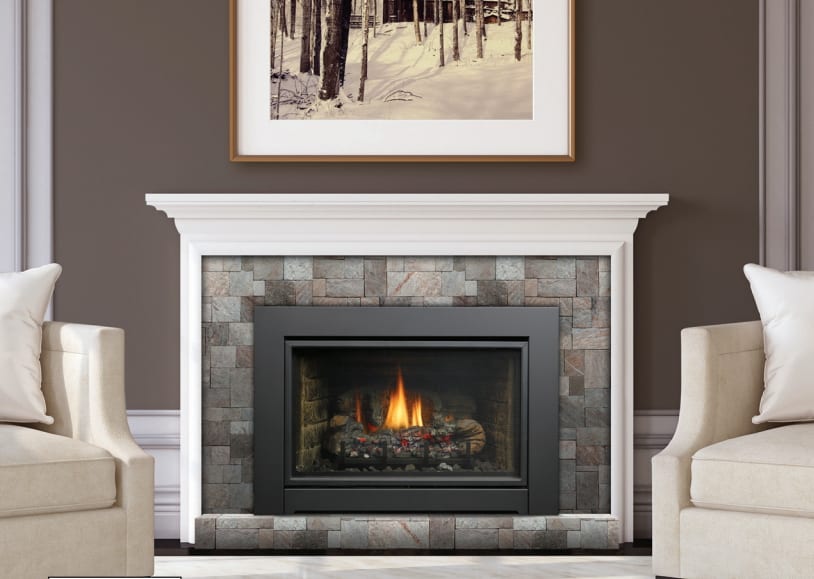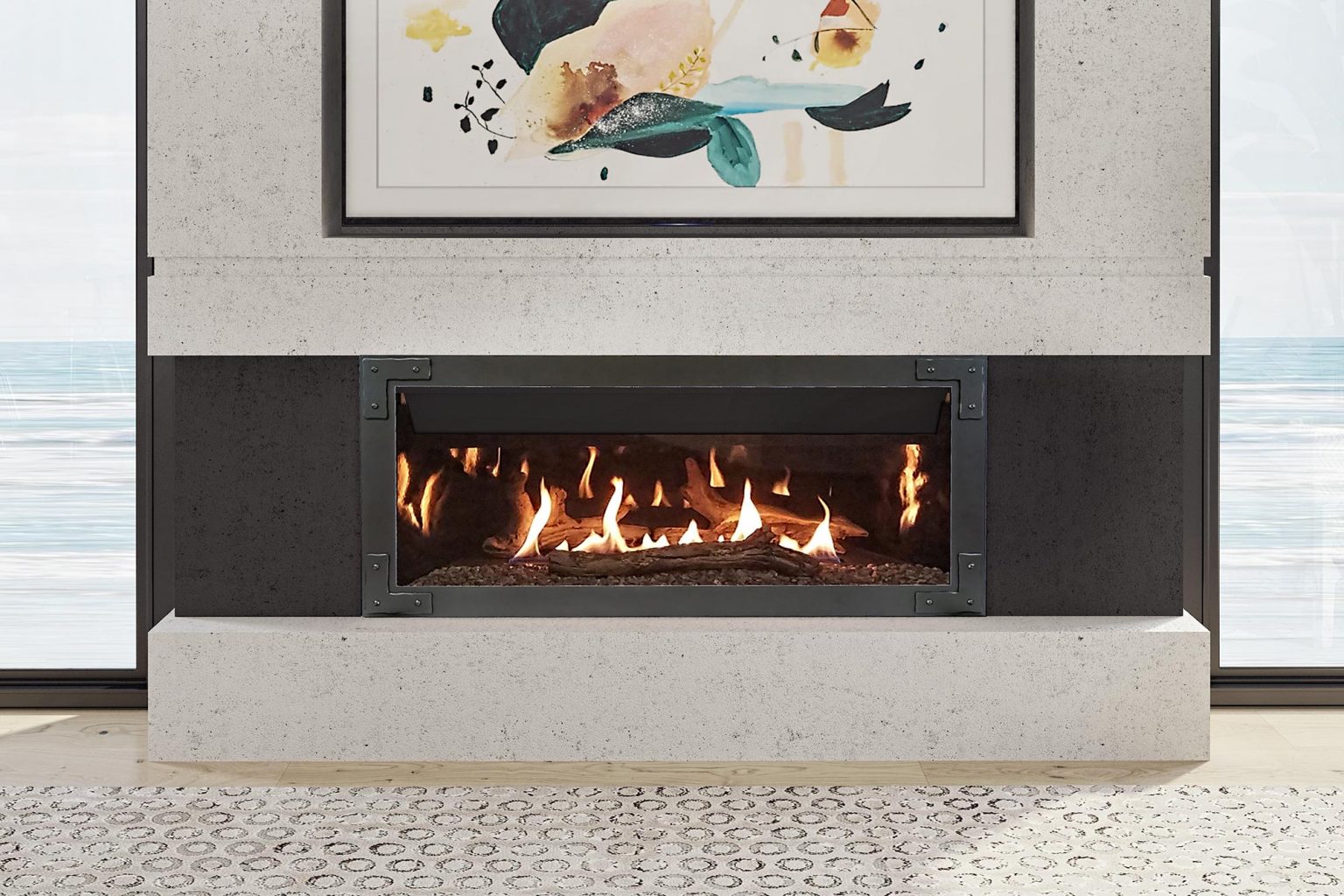Gas fireplaces have gained popularity for their efficient heating capabilities and cozy ambiance. In this comprehensive guide, we’ll delve into the advantages of gas fireplaces, key considerations for purchasing one, and provide insights into estimating gas fireplace costs. Let’s embark on this journey to discover the world of gas fireplaces.

Unlocking the Benefits of Gas Fireplaces: A Wise Investment?
Most homeowners spend the majority of their time in just a few rooms within their homes. Consider this: Why run your furnace, consuming 80,000 to 100,000 BTUs of gas, when a gas fireplace can comfortably warm the area you frequently occupy, using only 1/4 to 1/3 of the fuel? This approach, known as zone heating, allows you to selectively heat the spaces you use the most.
Gas fireplaces are an excellent way to add warmth to cooler rooms or to create a cozy atmosphere in your favorite living area. Gas fireplaces offer the perfect blend of convenience and comfort. With just a click of the remote control from your recliner, you can effortlessly adjust the heat, fan speed, and ambiance in your family room. They are incredibly user-friendly, efficiently delivering heat and comfort precisely where you need it, all while enhancing the aesthetics of your home with beautiful flames and boasting an impressive efficiency rating of 80% or more.
So, if you’re still wondering if a gas fireplace is worth it, the answer is an emphatic YES!
Choosing the Right Gas Fireplace: Which One Is Best?
Determining the “best” gas fireplace can be subjective, as personal preferences and specific requirements vary. However, everyone seeks solid value when making a purchase. Reliability, dependability, performance, aesthetics, and price are the key factors to consider.
When purchasing a gas fireplace, rely on Friendly Fires, who has carefully assessed all these factors. You’ll find reputable brands like Ambiance, Marquis, and more known for their consistent performance and excellent value. View all the gas fireplaces, inserts, and stoves we carry here.

Estimating Gas Fireplace Costs: What to Consider
The cost of a gas fireplace project can vary due to several factors. To provide a rough estimate, let’s break down the expenses into different categories:
- Fireplace itself: $3,000 – $9,000 (varies based on size and style).
- Venting components: Minimum horizontal vent kits start at $500, while complex installations may exceed $1,500.
- Framing, electric, and gas extensions: Typically range from $500 to $1,400.
- Finishing costs: The most variable aspect, with custom stone or brickwork exceeding $15,000 – $20,000, while basic finishes may cost around $500. A typical job with a mantle and simple tile or cultured brick or stone work ranges from $3,000 to $5,000.
Remember that regional variations can influence costs, so it’s advisable to involve us early in your gas fireplace project for accurate estimates.
Operating Costs of a Gas Fireplace
The gas consumption of your gas fireplace can be adjusted manually or with a remote control. The amount of gas used directly impacts flame height and heat output. The 30,000 BTU burner is using approximately .83 cubic meters/hour. Using the rate of 20¢ per cubic meter for natural gas (NG), your fireplace would cost approximately 17¢ per hour.
Meanwhile with liquid propane (LP), the burner is using about 1.25 litres/hour. By figuring an LP cost of $1 per litre, the cost to operate the fireplace would be about $1.25 per hour. Several factors may influence actual operating costs, such as usage patterns, thermostat settings, fluctuating fuel rates, and utility company charges.
Gas Fireplace vs. Gas Fireplace Insert: Understanding the Difference
It’s crucial to distinguish between gas fireplaces and gas fireplace inserts, as they serve distinct purposes. These terms are not interchangeable.
- Gas Fireplace: Designed to be built into a framed wall during construction or remodeling, offering a variety of sizes and venting options.
- Gas Fireplace Insert: Intended to slide into an existing wood-burning fireplace, enhancing its efficiency and convenience.
Select the appropriate option based on your specific needs and installation requirements.
Gas vs. Wood Fireplaces: Efficiency and Lifestyle
Gas and wood fireplaces have similar efficiency ratings, with new wood-burning equipment meeting 2020 EPA requirements, typically ranging from 75% to 80%. Most gas fireplaces fall within the low 70% to low 80% efficiency range.
Choosing between gas and wood largely depends on your lifestyle and preferences. Wood heat can be cost-effective, but it demands effort in procuring, cutting, and splitting wood. Consider factors like access to wood, equipment, time, energy, and health concerns when making your decision.
Remember the saying, “Wood heat will heat you four or five times,” emphasizing the effort involved in using wood as a fuel source. Opt for gas if you prioritize convenience.
Cooking on Your Gas Fireplace: Is It Possible?
Gas fireplaces with direct venting must operate with the glass in place to maintain a sealed combustion system. While some models offer optional decorative doors, these do not allow room air to enter the firebox. Therefore, cooking on a gas fireplace is not a feasible option. Stick to conventional cooking methods like using your oven, microwave, campfire, or grill for culinary endeavors.
Replacing Your Gas Fireplace: When Is It Necessary?
Gas fireplaces are built to last, especially those offered by Friendly Fires. However, there may come a time when replacement is warranted, typically after 15 to 20 years or when upgrading to benefit from the latest technology and innovations. If you’ve recently moved into a home with an older gas fireplace, consider replacing it to enjoy modern features, enhanced aesthetics, and simplified operation.

Recommendations for Gas Fireplace Placement
When selecting the ideal location for your gas fireplace, consider the following options:
- Kitchen, hallway, bathroom, living room, home office, family room, dining room, entryway, basement, bedroom, deck, patio, or outdoor living space.
- Choose between horizontal sidewall venting or vertical roof venting based on the fireplace model and your home’s layout.
- Consult with Friendly Fires, providing pictures of potential locations for personalized guidance.
Finding Your Perfect Gas Fireplace Placement: Tailoring the Warmth to Your Space

When contemplating where to install a gas fireplace in your home, it’s essential to consider your specific needs and preferences for that extra touch of warmth and comfort. Here are some ideal locations to contemplate:
- Kitchen: Enhance the heart of your home with a gas fireplace, making your cooking and dining experiences cozier.
- Hallway: Create a welcoming atmosphere in your hallway, setting the tone for your entire home.
- Bathroom: Add a touch of luxury to your bathroom, transforming it into a spa-like retreat.
- Living room: The classic choice for a gas fireplace, providing warmth and ambiance to your primary gathering space.
- Home office: Make your workspace more inviting and productive with the gentle heat and soothing flames of a gas fireplace.
- Family room: Extend the warmth and comfort to your family’s favorite relaxation spot.
- Dining room: Elevate your dining experiences with the allure of a gas fireplace.
- Entryway or foyer: Create a grand entrance by welcoming guests with the warmth and charm of a gas fireplace.
- Downstairs rec room: Enhance your basement’s entertainment area, making it an inviting retreat.
- Master or guest bedroom: Add a touch of romance and comfort to your bedroom with a gas fireplace.
- Deck, patio, or outdoor living room: Extend your outdoor season by installing a gas fireplace designed for the elements.
- On a wall adjacent to an open stairway: Elevate your home’s architectural features with a strategically placed gas fireplace.
Remember that proper venting is essential for your gas fireplace. You have two options: horizontal venting through a sidewall or vertical venting through the roof.
Consult your fireplace owner’s manual for the acceptable vent profile, detailing distance and height limitations for each model. When you visit your local Friendly Fires showroom, bring pictures of potential locations to discuss your ideas with experts.
Choosing the Right Gas Fireplace: Tailoring It to Your Needs
To find the gas fireplace that perfectly suits your situation, consult with Friendly Fires. While our sales representatives are your best resource, here are some valuable pointers for locating the ideal gas fireplace in your home:
- Decks, patios, and outdoor living spaces: Many manufacturers offer gas fireplaces designed for outdoor use. Ensure the model you choose can withstand the elements. These units are typically unvented, so you must ensure adequate fresh air for proper exhaust dissipation. Look for weather-resistant finishes, stainless steel components, wind deflectors, and gas safety valves.
- Bedrooms: To maintain a comfortable sleeping environment, opt for a gas fireplace with a smaller BTU output that won’t overheat the room. Consider the available wall space and choose between linear or portrait-style fireplaces that can be installed at a height ideal for enjoying the flames from your bed.
- Maximum Heat: If you desire substantial warmth, focus on BTUs. Look for a gas fireplace with a burner size exceeding 35,000 BTUs per hour. Consider strategies for distributing heat throughout the room to prevent overheating. Some high-BTU fireplaces support ducting, allowing warm air to reach adjacent rooms. Ceiling fans and vertical oscillating floor fans can further enhance air circulation.
- Basement Rooms: In colder climates, larger burners are often suitable for basements, even well-insulated ones. Basements can get chilly due to factors like insufficient return air ducts or poor insulation. Opt for a high-BTU fireplace and adjust the heat output as needed. Venting a gas fireplace from a basement can be a complex task, so consult professionals.
- Mobile Homes: The layout of mobile homes can present challenges. To ensure proper air circulation, consider using oscillating or ceiling fans. Adjusting the furnace fan to the “on” position can also help distribute air effectively. In mobile homes, smaller-frame fireplaces with larger burners are a wise choice for optimal comfort.
- Small Spaces: For compact areas, prioritize fireplaces with smaller burners and lower BTU outputs. Maintaining airflow is crucial to prevent overheating in these cozy spaces.
Your nearby Friendly Fires showroom offers a plethora of fireplace options to explore. Remember, we not only help you choose the right fireplace but also handle installation and servicing. With our professionalism and commitment to your satisfaction, you’ll embark on your gas fireplace project with confidence.
A gas fireplace offers a convenient and efficient heating solution while enhancing the ambiance of your home. Let us know if you have any questions either by contacting us or letting us know in the comments below.
Please also visit our Facebook Page to get regular information on the best fireplaces and bbqs around!






